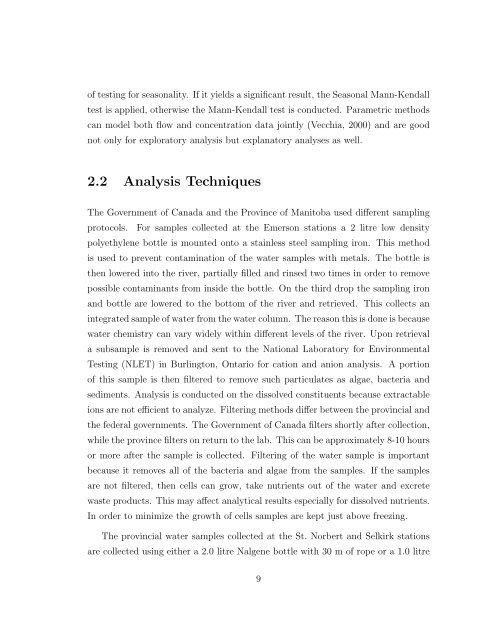Statistical Analysis of Trends in the Red River Over a 45 Year Period
Statistical Analysis of Trends in the Red River Over a 45 Year Period
Statistical Analysis of Trends in the Red River Over a 45 Year Period
Create successful ePaper yourself
Turn your PDF publications into a flip-book with our unique Google optimized e-Paper software.
<strong>of</strong> test<strong>in</strong>g for seasonality. If it yields a significant result, <strong>the</strong> Seasonal Mann-Kendall<br />
test is applied, o<strong>the</strong>rwise <strong>the</strong> Mann-Kendall test is conducted. Parametric methods<br />
can model both flow and concentration data jo<strong>in</strong>tly (Vecchia, 2000) and are good<br />
not only for exploratory analysis but explanatory analyses as well.<br />
2.2 <strong>Analysis</strong> Techniques<br />
The Government <strong>of</strong> Canada and <strong>the</strong> Prov<strong>in</strong>ce <strong>of</strong> Manitoba used different sampl<strong>in</strong>g<br />
protocols. For samples collected at <strong>the</strong> Emerson stations a 2 litre low density<br />
polyethylene bottle is mounted onto a sta<strong>in</strong>less steel sampl<strong>in</strong>g iron. This method<br />
is used to prevent contam<strong>in</strong>ation <strong>of</strong> <strong>the</strong> water samples with metals. The bottle is<br />
<strong>the</strong>n lowered <strong>in</strong>to <strong>the</strong> river, partially filled and r<strong>in</strong>sed two times <strong>in</strong> order to remove<br />
possible contam<strong>in</strong>ants from <strong>in</strong>side <strong>the</strong> bottle. On <strong>the</strong> third drop <strong>the</strong> sampl<strong>in</strong>g iron<br />
and bottle are lowered to <strong>the</strong> bottom <strong>of</strong> <strong>the</strong> river and retrieved. This collects an<br />
<strong>in</strong>tegrated sample <strong>of</strong> water from <strong>the</strong> water column. The reason this is done is because<br />
water chemistry can vary widely with<strong>in</strong> different levels <strong>of</strong> <strong>the</strong> river. Upon retrieval<br />
a subsample is removed and sent to <strong>the</strong> National Laboratory for Environmental<br />
Test<strong>in</strong>g (NLET) <strong>in</strong> Burl<strong>in</strong>gton, Ontario for cation and anion analysis. A portion<br />
<strong>of</strong> this sample is <strong>the</strong>n filtered to remove such particulates as algae, bacteria and<br />
sediments. <strong>Analysis</strong> is conducted on <strong>the</strong> dissolved constituents because extractable<br />
ions are not efficient to analyze. Filter<strong>in</strong>g methods differ between <strong>the</strong> prov<strong>in</strong>cial and<br />
<strong>the</strong> federal governments. The Government <strong>of</strong> Canada filters shortly after collection,<br />
while <strong>the</strong> prov<strong>in</strong>ce filters on return to <strong>the</strong> lab. This can be approximately 8-10 hours<br />
or more after <strong>the</strong> sample is collected. Filter<strong>in</strong>g <strong>of</strong> <strong>the</strong> water sample is important<br />
because it removes all <strong>of</strong> <strong>the</strong> bacteria and algae from <strong>the</strong> samples. If <strong>the</strong> samples<br />
are not filtered, <strong>the</strong>n cells can grow, take nutrients out <strong>of</strong> <strong>the</strong> water and excrete<br />
waste products. This may affect analytical results especially for dissolved nutrients.<br />
In order to m<strong>in</strong>imize <strong>the</strong> growth <strong>of</strong> cells samples are kept just above freez<strong>in</strong>g.<br />
The prov<strong>in</strong>cial water samples collected at <strong>the</strong> St. Norbert and Selkirk stations<br />
are collected us<strong>in</strong>g ei<strong>the</strong>r a 2.0 litre Nalgene bottle with 30 m <strong>of</strong> rope or a 1.0 litre<br />
9
















